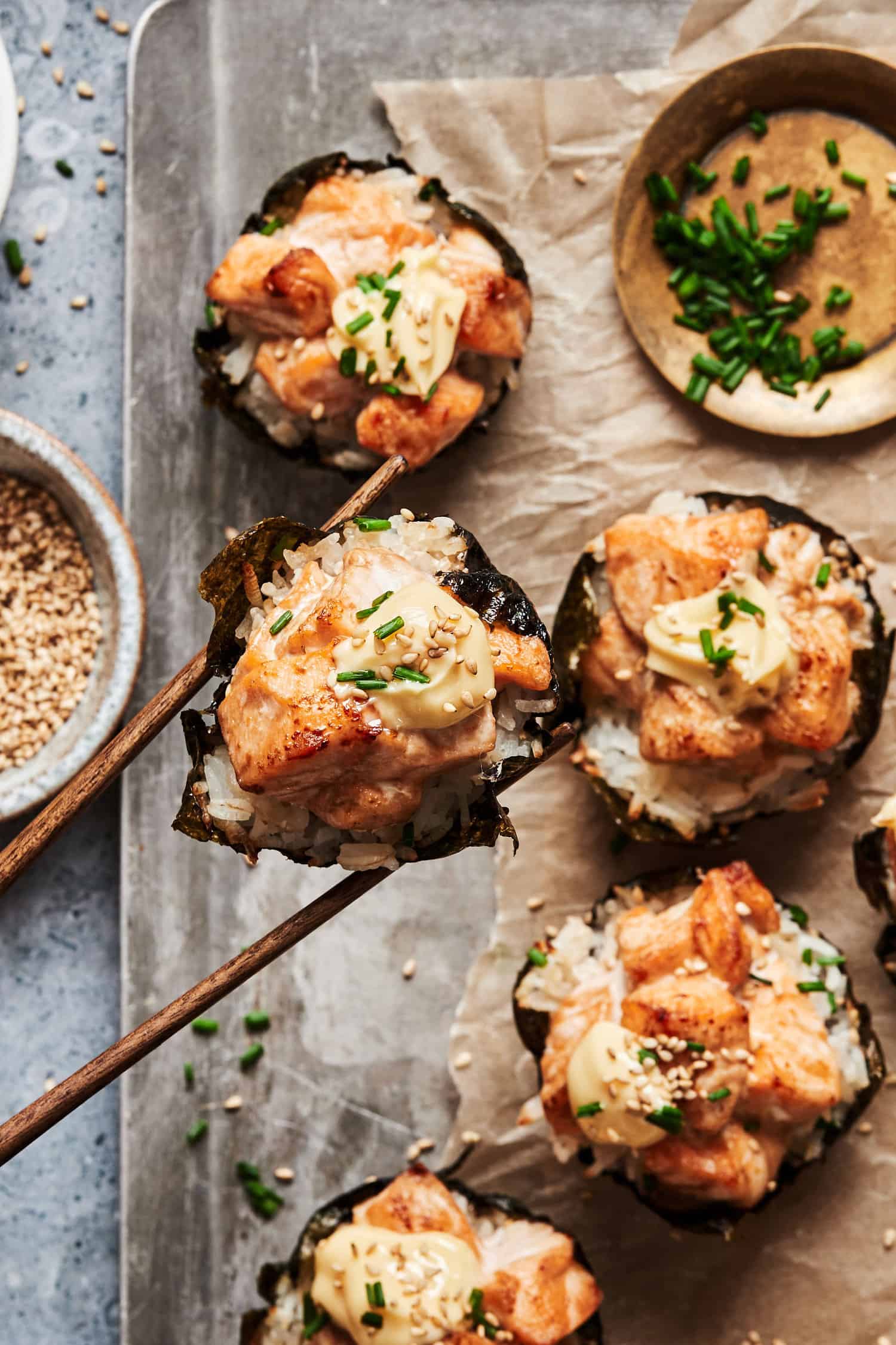Ahi Sushi Cups: A Bite-Sized Twist on Traditional Sushi
Ahi Sushi Cups combine the flavors of traditional sushi with a modern presentation. These cups use bite-sized containers made from seaweed or crispy wonton wrappers, filled with seasoned rice, ahi tuna, and various garnishes. Their small size makes them perfect for parties, appetizers, and quick snacks. They are customizable with simple ingredients and creativity, allowing everyone to enjoy a personalized taste experience.
The Origin of Ahi Sushi Cups
Ahi Sushi Cups emerged as a contemporary adaptation of classic sushi. Drawing inspiration from Japanese culinary traditions and the art of sushi-making, these cups aim to provide a more approachable and convenient serving style. Influenced by the popularity of bite-sized hors d’oeuvres in Western cuisine, chefs began creating these sushi cups to cater to modern tastes and dining experiences.
Key Ingredients in Ahi Sushi Cups
Understanding Ahi Tuna
Ahi tuna, also known as yellowfin tuna, serves as the star ingredient in Ahi Sushi Cups. This fish, popular for its rich flavor and firm texture, is often used in sushi and sashimi. High in protein and omega-3 fatty acids, Ahi tuna not only provides a savory taste but also offers nutritional benefits. It’s important to source sashimi-grade tuna to ensure quality and safety. Freshness is key when selecting your Ahi tuna for the best flavor and texture in your sushi cups.
Additional Components of Sushi Cups
Several essential components form the foundation of a delicious Ahi Sushi Cup:
- Seasoned Rice: Sushi-grade short-grain rice, seasoned with vinegar, sugar, and salt, acts as the base. This rice holds the ingredients together while adding a slight tangy flavor.
- Wrappers: Choose between seaweed (nori) or crispy wonton wrappers. Nori offers a traditional touch, while wonton wrappers add a crunchy texture.
- Vegetables: Common choices include cucumber, avocado, and radish. These vegetables provide a fresh contrast and enhance the visual appeal.
- Toppings: Garnishes like sesame seeds, green onions, and pickled ginger add additional layers of flavor and texture. These toppings also contribute to the overall presentation.
- Sauces: Drizzle with soy sauce, spicy mayo, or ponzu for a burst of flavor. These sauces complement the tuna and bring the ingredients together.
Here, the combination of these key ingredients results in the unique, satisfying flavors of Ahi Sushi Cups.
How to Make Ahi Sushi Cups at Home
Necessary Tools and Ingredients
To make Ahi Sushi Cups at home, gather the following tools and ingredients. Quality ingredients and proper tools ensure the best results.
Tools
- Sharp Knife: Essential for slicing Ahi tuna and vegetables.
- Cutting Board: Provides a stable surface for preparation.
- Muffin Tin: Ideal for shaping wrappers.
- Rice Cooker: Ensures perfectly cooked sushi rice.
- Mixing Bowls: Useful for mixing rice and other components.
- Spoon or Scoop: Helps in filling the cups.
Ingredients
- Ahi Tuna: 1/2 pound, sashimi-grade, for quality taste and texture.
- Sushi Rice: 1 cup, cooked and seasoned with rice vinegar, sugar, and salt.
- Wrappers: Seaweed or wonton, depending on preference.
- Vegetables: Avocado, cucumber, and carrots, sliced thin for crunch and flavor.
- Toppings: Pickled ginger, sesame seeds, and green onions, for added taste and presentation.
- Sauces: Soy sauce, wasabi, and spicy mayo, for dipping and drizzling.
Step-by-Step Recipe
Follow these steps to make Ahi Sushi Cups at home. Each step builds upon the previous one to create a cohesive dish.
- Prepare Sushi Rice: Rinse 1 cup of sushi rice under cold water until the water runs clear. Cook the rice using a rice cooker or stovetop method. Mix the cooked rice with a tablespoon of rice vinegar, a teaspoon of sugar, and a pinch of salt. Allow it to cool.
- Shape Wrappers: Preheat your oven to 350°F (175°C). Place seaweed or wonton wrappers into the muffin tin, pressing them gently to form cup shapes. Bake for 5-7 minutes if using wonton wrappers, until they turn golden brown and crispy. Skip baking for seaweed wrappers.
- Slice Ahi Tuna: Using a sharp knife, slice the sashimi-grade Ahi tuna into small, bite-sized cubes. Set aside in a mixing bowl.
- Prepare Vegetables: Thinly slice avocado, cucumber, and carrots using a sharp knife or mandoline. These vegetables add both texture and flavor to the cups.
- Assemble Cups: Fill each wrapper cup with a spoonful of seasoned sushi rice. Add a few pieces of the sliced Ahi tuna on top of the rice. Arrange the sliced vegetables over the tuna.
- Add Toppings: Garnish each cup with pickled ginger, sesame seeds, and finely chopped green onions.
Nutritional Benefits of Ahi Sushi Cups
Health Benefits of Ahi Tuna
Ahi tuna, the core of Ahi Sushi Cups, offers significant health benefits. This fish is rich in high-quality protein, providing about 24 grams per 4-ounce serving. Protein plays a crucial role in muscle repair and growth. Additionally, Ahi tuna contains ample omega-3 fatty acids, which improve heart health by reducing blood pressure and lowering triglyceride levels. The fish is also a good source of essential vitamins and minerals, such as vitamin D and selenium, which support immune function and antioxidant defense.
Overall Nutritional Profile
Ahi Sushi Cups combine several nutritious ingredients. Sushi rice, often found in these cups, is a good source of carbohydrates, offering energy for daily activities. Depending on the wrappers used, such as seaweed or wonton, you can gain different benefits. Seaweed is rich in iodine, potassium, and some vitamins, while wontons add a bit of crunch and flavor diversity.
| Nutrient | Amount per Serving (Cups) |
|---|---|
| Calories | 200-250 kcal |
| Protein | 24 grams |
| Carbohydrates | 30 grams |
| Fats | 5 grams |
| Omega-3 Fatty Acids | 0.5 grams |
| Sodium | 400 mg |
| Vitamin D | 400 IU |
| Selenium | 45 mcg |
Vegetables in Ahi Sushi Cups, such as avocado, cucumber, and radishes, offer fiber, vitamins, and minerals. Avocado adds healthy fats, particularly monounsaturated fats, which are good for heart health. Toppings and sauces, when used in moderation, enhance flavor without significantly altering the nutritional balance.
Where to Find the Best Ahi Sushi Cups
Restaurants and Sushi Bars
To experience the best Ahi Sushi Cups, visit top-rated sushi restaurants and sushi bars. Establishments such as Nobu, Sushi Nakazawa, and Morimoto offer premium Ahi Sushi Cups known for their quality and presentation. Chefs at high-end sushi bars emphasize fresh, high-quality ingredients, ensuring each bite-size serving is meticulously crafted. You can also explore local favorites, like sushi establishments listed in city food guides or popular review sites, for hidden gems offering exceptional Ahi Sushi Cups. Keep an eye on seasonal menus, as some restaurants may feature Ahi Sushi Cups as specialty items.
Online Recipes and Resources
Creating Ahi Sushi Cups at home is easy with the plethora of online recipes and resources available. Websites like AllRecipes, Food Network, and Bon Appétit provide detailed recipes, including ingredient lists, preparation instructions, and video tutorials. You can also explore cooking blogs and YouTube channels dedicated to sushi or Japanese cuisine for step-by-step guides and tips from culinary experts. These resources often include variations and personalized touches, allowing you to customize your Ahi Sushi Cups to suit your taste preferences.
Conclusion
Ahi Sushi Cups offer a delightful fusion of traditional sushi flavors with a modern twist, making them perfect for any occasion. Their bite-sized nature and customizable ingredients ensure that you can tailor them to your taste preferences while enjoying a nutritious and balanced meal. With the health benefits of Ahi tuna and a variety of fresh vegetables, these sushi cups are both delicious and good for you. Whether you choose to enjoy them at top-rated sushi restaurants or make them at home using online recipes, Ahi Sushi Cups are sure to impress and satisfy your culinary cravings.






